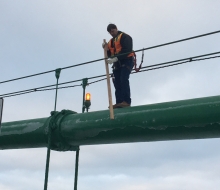Mackinac Bridge reopens following fourth falling ice closure; future closures remain likely
Though ice stopped falling long enough for the Mackinac Bridge Authority (MBA) to reopen the bridge today, the remaining ice leaves open the possibility of additional closures in the days ahead.
On Saturday, during the weekend’s first closure, MBA steeplejacks were able to scale the main cables and knock some loose ice off, enough to reopen the bridge. That was only possible this time because the ice was on the sides and bottom of the cable, not the top where they were walking. Though MBA staff attempted to loosen some of the remaining ice on the bridge by driving loaded sand trucks across the bridge, ice remained on the main cables and towers.
During the latest closure, the bridge closed due to falling ice on Sunday morning just after 8 a.m., and reopened just before noon. Following the opening, the bridge stayed closed to high-profile vehicles due to high winds until about 5 p.m., when it was fully reopened.
Based on predicted sunny and warmer weather, the remaining ice is likely to begin falling from the bridge in the next few days.
“It’s impossible to say exactly when the ice could start falling from the bridge again, though predicted conditions make it likely it will begin falling soon,” said MBA Executive Secretary Bob Sweeney. “We would advise customers that if they are planning a trip across the Straits, additional closures are possible.”
The bridge has already been closed due to falling ice four times in 2018, including Sunday’s closure, and 20 times total according to MBA records. The bridge was closed 19 hours, 44 minutes, on Jan. 26 and 27, 2018; 11 hours, 50 minutes, on Feb. 20 and 21, 2018; and 20 hours, 15 minutes, on Feb. 23 and 24, 2018.
The second February closure was the longest for falling ice; the shortest closure was 37 minutes in 2001. The bridge closed three times in 2016, and four in 2017, meaning that more than half of all falling ice closures have occurred in the past three winters. The three longest duration falling ice closures – 15 hours, 45 minutes; 19 hours, 44 minutes; and 20 hours 15 minutes – all took place in the past year.
“The last few years, freezing rain and mid-winter warm-ups have been more frequent, and we’ve had more closures for falling ice,” Sweeney said. “Though it is getting to be more common, we still can’t reliably predict when it will occur, or how long these closures will last.”
Sheets and chunks of ice falling hundreds of feet from the bridge towers and cables have the potential to severely damage vehicles and injure or kill passengers in them. Crews monitor bridge conditions throughout any closure, both by going out on the bridge and through the MBA’s network of cameras located across the span.
Mackinac County 911, using its RAVE Alert System, will send updates and information from the MBA to users’ cell phones any time the bridge has a partial or full closure due to weather or other conditions. Messages also will be sent when a full closure is reduced to a partial closure or when the bridge reopens to all traffic. To sign up, text “MacBridge” to 67283.
Details and updates are also available around the clock at http://www.mackinacbridge.org/fares-traffic/conditions/. The Michigan Department of Transportation (MDOT) posts information on closures on Twitter and Facebook, as well as on freeway dynamic message signs.






